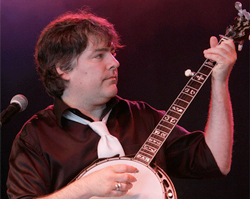by Tom Wachunas

It’s certainly an effective tool for highlighting various sections or soloists at work, but only if the camera shots are properly coordinated with the music. On this occasion there were some shortcomings in that regard, not unlike seeing footage of football players sitting on the sidelines while a big scoring play transpires on the field. That said, I’m sure that this new element will be successfully adjusted to become a great enhancement of the concert experience.
The first work of the evening was Béla Bartók’s Romanian Folk Dances, and the orchestra was in peak form as it delivered all the dances’ exotic modalities, rhythms and mood shifts. Including the work on this program had an added significance. The thematic eclecticism of Bartók’s music (springing from his seminal work in ethnomusicology) was a fitting foretaste of the wildly varied musical contexts explored by another Béla (named, in fact, after Bartók) – the inimitable contemporary banjoist and composer, Béla Fleck – in his The Impostor, Concerto for Banjo and Orchestra.
No doubt many in the audience were already familiar with Fleck’s genius for expanding the parameters of the humble banjo far beyond folk and bluegrass genres to include ambitious fusions with jazz and classical idioms. For the uninitiated, and judging from the effusive response of the entire audience at the conclusion of his performance, this was indeed a surprising, ear-opening adventure of the most delightful sort.
Composed in 2011, the work is in three movements, titled Infiltration, Integration and Truth Revealed, which treat the banjo as a “hero” who, in Fleck’s words, “…is trying to avoid the truth of who he is, but in the end cannot avoid it.” And so it is that Fleck’s concerto is a progressive jaunt through intricate articulations that at times echo Bach toccatas, shades of Stravinsky or Bartók, and hints of Copeland lyricism.
The work is laced with contrapuntal playfulness and piquant call-and-response passages between soloist and orchestra. Throughout, Fleck’s technical agility was astonishingly relaxed and fluid, and many of its mesmerizing, virtuosic passages were punctuated by his gentle nod of approval to the orchestra followed by a warm, wide-eyed smile to the audience.
Most impressive was an unexpected range of expressive tonalities emanating from the banjo, always flawlessly balanced with the ensemble. The invigorating third movement, flavored with Gershwin-like swagger, built to a jaw-dropping banjo cadenza that paraded the music back to Fleck’s roots in bluegrass and the music of Earl Scruggs, to whom the work was originally dedicated.
Not surprisingly, the audience clamored for an encore. Fleck gladly obliged with an enthralling jazz-style improvisation on the theme song from the 1960s television comedy, The Beverly Hillbillies. Imagine if you can a meeting between Charlie Parker and Earl Scruggs.
While it’s true that Fleck’s concerto effectively employed a range of intoxicating textures and colors that a full orchestra can bring to such a work, a concert by this orchestra would feel somehow unsatisfying without showcasing even further the sheer breadth of its sonority and unfettered emotive power. To that end, the final work on the program, César Franck’s Symphony in D minor, rounded out the evening with breathtaking radiance.
But wait, there’s more! The ‘Surprise’? Maestro Gerhardt Zimmermann called for Bob Leibensperger, CSO Board of Trustees member and Chair of the Capital Campaign project for the building of the new Zimmermann Symphony Center, to join him on stage. As CSO Assistant Conductor Rachel Waddell stepped up to the podium to lead the orchestra, both men took a seat facing each other, Leibensperger comfortably settled in an easy chair. Then, Zimmermann gifted him with a reading of Garrison Keillor’s The Young Lutheran’s Guide to the Orchestra.
It’s a hilarious, tongue-in-cheek admonition to those of the Lutheran persuasion who might be considering a career as classical musicians. The text is an inventory of the instruments in a modern orchestra, assessing their “spiritual” desirability (or lack thereof). The accompanying music was composed by Randall Davidson, arranged around two hymns, Beautiful Savior and Jesus Loves Me. At one point Zimmermann was “singing” a refrain with exaggerated solemnity. With this memorable display of avuncular good humor, the evening was truly complete.
Published on ClevelandClassical.com March 25, 2014
Click here for a printable version of this article.



